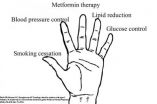(Press-News.org) Scottsdale, Ariz., February 20, 2014—Oropharyngeal cancer patients treated with combined chemotherapy and radiation therapy reported a decrease in their voice and speech quality (VSQ) for up to one year after the completion of treatment, according to research presented today at the 2014 Multidisciplinary Head and Neck Cancer Symposium. The study further shows that limiting the dose of radiation to the glottic larynx (GL) to less than 20 Gy resulted in a decrease in post-treatment VSQ problems, and that patient-reported VSQ indicated more adverse effects from treatment compared to independent physician assessment.
The research evaluated the VSQ of 91 patients with stage III/IV oropharyngeal cancer (OPC) at the University of Michigan. The patients were treated from 2003-2011 on two prospective studies of definitive concurrent chemotherapy and radiation therapy (CRT), using advanced intensity modulated radiation therapy (IMRT) techniques intended to minimize the radiation dose to the pharyngeal constrictors, salivary glands, oral cavity (OC, the inside region of the mouth), GL, supraglottic larynx and esophagus.
Patients' voice and speech problems were evaluated and reported independently by patients and their physicians. Patient-reported VSQ was assessed using the communication domain of the University of Michigan's Head and Neck Quality of Life (HNQOL-C) questionnaire and the single speech question on the University of Washington Quality of Life (UWQOL-S) questionnaire. Patients completed questionnaires prior to treatment, and one, three, six, 12, 18 and 24 months after CRT. Factors associated with worsening patient-reported VSQ were assessed and were defined as a decrease in HNQOL-C or UWQOL-S scores from the patients' baseline evaluations.
A maximum decrease in VSQ was reported at one month post-treatment, with 68 percent of patients reporting worsening HNQOL-C scores and 41 percent reporting lower UWQOL-S scores. Improvements to the scores were seen thereafter, with patients on average reporting scores back to baseline by 12 months post-treatment when scored on the HNQOL-C and by 18 months post-treatment when scored on the UWQOL-S. At 12 months after treatment, however, one-third of patients continued to report a decrease in VSQ compared to baseline, with 33 percent showing lower HNQOL-C scores and 28 percent showing lower UWQOL-S scores.
In contrast, physician assessment was much less sensitive to voice and speech problems at post-treatment, with VSQ reported (grade one toxicity) by physicians in only 5 percent of patients at three months and 0 percent at either one or two years.
On further analysis, voice quality worsening (as reported by patients) was closely related to the radiation dose received by the GL (the voice box), while patient-perceived speech difficulty was related to radiation dose received by both the GL and OC. Worse patient-reported HNQOL-C scores at six months post-treatment were correlated with mean radiation dose to the GL, with 25 percent of those whose GL received less than 20 Gy; 33 percent who received >20-30 Gy; 59 percent who received >30-40 Gy; 50 percent who received >40-50 Gy; and 64 percent who received >50 Gy reporting worse scores at six months compared to pre-treatment. The association of worse HNQOL-C scores with dose to the GL persisted at the 12-month post-treatment mark, as reported by 10 percent of patients whose GL received less than 20 Gy; 32 percent receiving >20-30 Gy; 25 percent receiving >30-40 Gy; 30 percent receiving >40-50 Gy; and 63 percent receiving >50 Gy, (χ2 for trend p=0.02 at six months, p=0.011 at 12 months).
"In contrast to chronic mouth dryness and swallowing difficulties, which have been recognized for years as potential complications in patients receiving radiation therapy for cancers of the head and neck, relatively little attention has been directed to treatment-related changes in voice and speech quality," said Jeffrey Vainshtein, MD, lead author of the study and chief resident in the Department of Radiation Oncology at the University of Michigan. "The wide discrepancy between patient- and physician-reporting of voice and speech changes in our study underscores the fact that physicians may tend to underestimate the detrimental effects of head and neck radiation on this aspect of our patients' quality of life. Our findings suggest that minimizing the radiation dose to the voice box and oral cavity in situations where they are not at risk of involvement by cancer is likely to reduce voice and speech problems, and thus improve post-treatment quality of life. Additionally, our research serves as a reminder of the critical role that patient-reported outcomes must continue to play in guiding modifications to our current therapies in order to ultimately improve our patients' quality of life."
INFORMATION:
The abstract, "Prospective Study of Voice and Speech Quality After Chemo-IMRT for Oropharyngeal Cancer - Clinical and Dosimetric Predictors & Differences between Patient and Observer Reporting," will be a Poster Presentation at the 2014 Multidisciplinary Head and Neck Cancer Symposium. To speak with Dr. Vainshtein, contact Michelle Kirkwood on February 20 – 21, 2014 in the ASTRO Press Office at the JW Marriott Camelback Inn Resort and Spa in Scottsdale, Arizona at 480-596-7085 or email michellek@astro.org.
The 2014 Multidisciplinary Head and Neck Cancer Symposium is sponsored by the American Society for Radiation Oncology (ASTRO), the American Society of Clinical Oncology (ASCO) and the American Head & Neck Society (AHNS). The two-and-a-half day meeting includes interactive educational sessions focused on topics such as supportive care, directed therapy, new surgical and radiotherapeutic techniques, as well as 12 oral abstract presentations of the current science of relevance to the head and neck cancer community. A total of 189 abstracts will be presented including 177 posters. Keynote speakers include Jennifer Grandis, MD, of the University of Pittsburgh, to present "The Molecular Road to Defining and Targeting High-risk Head and Neck Patients;" and Julia H. Rowland, PhD, of the National Cancer Institute, to present "Cancer Survivorship: Research Opportunities on the Path to Where We Want to Be."
Embargoed until 8:00 a.m. MT, Thursday, February 20, 2014
2014 Multidisciplinary Head and Neck Cancer Symposium
News Briefing, Friday, February 21, 2014, 7:00 a.m. Mountain time
Poster Presentation: 121 Prospective Study of Voice and Speech Quality After Chemo-IMRT for Oropharyngeal Cancer - Clinical and Dosimetric Predictors & Differences between Patient and Observer Reporting
J. M. Vainshtein, K. Griffith, F. Y. Feng, K. Vineberg, F. Worden, C. R. Bradford, G. T. Wolf, D. B. Chepeha, A. Eisbruch, University of Michigan, Ann Arbor, MI
Background: Although adverse sequelae of chemoradiation (CRT) for head and neck cancer (HNC) have been extensively detailed in recent years, the effects of CRT on voice and speech quality (VSQ) remain poorly characterized. We investigated changes in patient-reported VSQ after CRT in two prospective studies of organ-sparing CRT for locally advanced oropharyngeal cancer (OPC).
Methods and Materials: 91 patients with stage III/IV OPC treated at our institution on two prospective studies of definitive CRT from 2003-2011 were included. All received whole-field neck IMRT intended to minimize dose to the pharyngeal constrictors, salivary glands, oral cavity (OC), glottic larynx (GL), supraglottic larynx, and esophagus. PRVSQ was assessed by the Communication Domain of the Head and Neck Quality of Life (HNQOL-C) questionnaire and the Speech question of the University of Washington QOL (UWQOL-S) questionnaire at pretreatment and 3, 6, 12, 18, and 24 months after CRT. Factors associated with worsening patient-reported VSQ (defined as a decrease in HNQOL-C or UWQOL-S from baseline) were assessed.
Results: Patient-reported VSQ decreased maximally at 1-month, with 68% and 41% of patients reporting worsening HNQOL-C and UWQOL-S scores compared to baseline, and improved thereafter, with recovery of mean population HNQOL-C and UWQOL-S scores to baseline by 12 and 18 months, respectively. At 12 months, however, 33% and 28% of patients continued to report lower HNQOL-C and UWQOL-S scores, respectively, than prior to CRT. In contrast to patient-reported effects, observer-rated larynx toxicity was rare, with only grade 1 toxicity reported by 5% at 6 months and 0% at 12 months. Of patients with mean GL dose of less than 20 Gy, >20-30 Gy, >30-40 Gy, >40-50 Gy, and >50 Gy, 25%, 33%, 59%, 50%, and 64% reported worse HNQOL-C scores at 6 months compared to pretreatment, which persisted at 12 months in 10%, 32%, 25%, 30%, and 63% of patients, respectively (χ2 for trend p=0.02 at 6 months, p=0.011 at 12 months). Results using a worsening UWQOL-S score endpoint were similar. Mean GL dose, mean OC dose, N2/3 stage, and shorter time since RT completion were associated with worsening HNQOL-S (p<0.05) on univariate analysis. On multivariate analysis, mean GL dose remained independently predictive for worsening HNQOL-S after CRT (odds ratio 1.08 per Gy; p END
Patients with oropharyngeal cancer report quality of voice and speech affected post-treatment
Study indicates limiting radiation dose to the glottic larynx beneficial
2014-02-20
ELSE PRESS RELEASES FROM THIS DATE:
Reducing RT dose to bilateral IB lymph nodes results in better patient-reported salivary function
2014-02-20
Scottsdale, Ariz., February 20, 2014—For head and neck cancer patients undergoing radiation therapy, a reduction in the amount of radiation treatment volume to the submandibular (level IB) lymph nodes resulted in better patient-reported salivary function, according to research presented today at the 2014 Multidisciplinary Head and Neck Cancer Symposium. The study results also found significant reductions in radiation dose to the salivary organs, and good local regional control.
Researchers evaluated 125 patients with node-positive oropharyngeal cancer who received chemoradiation ...
Unilateral radiation therapy for advanced stage tonsil cancer results in favorable outcomes
2014-02-20
Scottsdale, Ariz., February 20, 2014—Limiting radiation therapy to lymph nodes on one side of the neck for advanced tonsil cancer resulted in good local regional control and no cancer recurrence on the untreated side, according to research presented today at the 2014 Multidisciplinary Head and Neck Cancer Symposium. Additionally, the study results indicate that primary tumor location, rather than the amount of lymph node involvement on the tumor side of the neck, dictates the risk for disease in the opposite side of the neck.
The study focused on 46 out of 153 total patients ...
MATH, HPV status in HNSCC patients effective markers of improved patient outcome
2014-02-20
Scottsdale, Ariz., February 20, 2014—Evaluating next-generation sequencing (NGS) data and associated clinical records of head and neck squamous cell carcinoma (HNSCC) patients from several institutions, made available through The Cancer Genome Atlas (TCGA), showed that combining Mutant-Allele Tumor Heterogeneity (MATH) as a biomarker with the patient's HPV status provides an effective indicator of improved patient outcome, according to research presented today at the 2014 Multidisciplinary Head and Neck Cancer Symposium.
The TCGA data available for HNSCC patients included ...
Rural primary care physicians are committed to professionalism, quality improvement
2014-02-20
The increased demand for primary care services expected to result from the Affordable Care Act (ACA) may be felt strongly in rural areas. While studies have found that the quality of care delivered to rural patients is as good or better than that available in urban areas, the belief persists that top-quality primary care is only available in big cities. But a new study appearing in the National Rural Health Association's Journal of Rural Health finds few meaningful differences between rural and urban primary care physicians on key measures of professionalism, including ...
Study examines correctional officer stress
2014-02-20
HUNTSVILLE, TX (2/20/14) -- Conflicts between work and family life were the most significant issues that affect work stress and job satisfaction among correctional officers, a new study by the Correctional Management Institute of Texas at Sam Houston State University found.
In a study of 441 correctional officers from adult prisons in the South, the most significant work-home issues experienced by correctional officers were demands and tensions from work that impact their home life; an incompatibility between the officer's role at work and at home; and family circumstances ...
Meet your match: Using algorithms to spark collaboration between scientists
2014-02-20
Speed dating, in which potential lovers size each other up in brief 10 minute encounters before moving on to the next person, can be an awkward and time-wasting affair. Finding the perfect research partnership is often just as tough. Speed dating-style techniques are increasingly used at academics conferences, but can be equally frustrating - with busy academics being pushed into too many pointless encounters.
But now a group of scientists led by geneticist Rafael Carazo Salas have constructed a system that could revolutionise conference speed dating - by treating scientists ...
Editorial illustrates shift away from glycemic control in diabetes treatment
2014-02-20
BOSTON (February 20, 2014)—An editorial in a February issue of American Family Physician proposes a simple way for physicians to communicate with patients about the best treatments for diabetes. The "lending a hand" illustration reprioritizes treatment goals, based on research on mortality reduction, to convey that glycemic control is no longer the primary intervention.
In order of benefit, to improve length and quality of life, patients with type 2 diabetes benefit from these interventions, starting with smoking cessation:
"Glycemic control is stuck in people's minds ...
Why are some children more resilient to post-traumatic stress?
2014-02-20
New Rochelle, NY, February 20, 2014—Children exhibit a range of responses to traumatic events such as natural disasters, with some suffering acute traumatic reactions that resolve over time and others experiencing long-term symptoms of post-traumatic stress. Identifying factors that may help predict which youths are at greater risk of more serious disorders and which are likely to be more resilient following a traumatic event can help determine the care and services needed, according to an article in Journal of Child and Adolescent Psychopharmacology (JCAP), a peer-reviewed ...
What is El Nino Taimasa?
2014-02-20
During very strong El Niño events, sea level drops abruptly in the tropical western Pacific and tides remain below normal for up to a year in the South Pacific, especially around Samoa. The Samoans call the wet stench of coral die-offs arising from the low sea levels "taimasa" (pronounced [kai' ma'sa]). Studying the climate effects of this particular variation of El Niño and how it may change in the future is a team of scientists at the International Pacific Research Center, University of Hawai'i at Mānoa and at the University of New South Wales, Australia.
Two El ...
Remote Antarctic telescope reveals gas cloud where stars are born
2014-02-20
Using a telescope installed at the driest place on earth - Ridge A in Antarctica – a UNSW-led team of researchers has identified a giant gas cloud which appears to be in an early stage of formation.
Giant clouds of molecular gas – the most massive objects in our galaxy – are the birthplaces of stars.
"This newly discovered gas cloud is shaped like a very long filament, about 200 light years in extent and ten light years across, with a mass about 50,000 times that of our sun," says team leader, Professor Michael Burton, an astronomer at UNSW Australia.
"The evidence suggests ...
LAST 30 PRESS RELEASES:
Why nail-biting, procrastination and other self-sabotaging behaviors are rooted in survival instincts
Regional variations in mechanical properties of porcine leptomeninges
Artificial empathy in therapy and healthcare: advancements in interpersonal interaction technologies
Why some brains switch gears more efficiently than others
UVA’s Jundong Li wins ICDM’S 2025 Tao Li Award for data mining, machine learning
UVA’s low-power, high-performance computer power player Mircea Stan earns National Academy of Inventors fellowship
Not playing by the rules: USU researcher explores filamentous algae dynamics in rivers
Do our body clocks influence our risk of dementia?
Anthropologists offer new evidence of bipedalism in long-debated fossil discovery
Safer receipt paper from wood
Dosage-sensitive genes suggest no whole-genome duplications in ancestral angiosperm
First ancient human herpesvirus genomes document their deep history with humans
Why Some Bacteria Survive Antibiotics and How to Stop Them - New study reveals that bacteria can survive antibiotic treatment through two fundamentally different “shutdown modes”
UCLA study links scar healing to dangerous placenta condition
CHANGE-seq-BE finds off-target changes in the genome from base editors
The Journal of Nuclear Medicine Ahead-of-Print Tip Sheet: January 2, 2026
Delayed or absent first dose of measles, mumps, and rubella vaccination
Trends in US preterm birth rates by household income and race and ethnicity
Study identifies potential biomarker linked to progression and brain inflammation in multiple sclerosis
Many mothers in Norway do not show up for postnatal check-ups
Researchers want to find out why quick clay is so unstable
Superradiant spins show teamwork at the quantum scale
Cleveland Clinic Research links tumor bacteria to immunotherapy resistance in head and neck cancer
First Editorial of 2026: Resisting AI slop
Joint ground- and space-based observations reveal Saturn-mass rogue planet
Inheritable genetic variant offers protection against blood cancer risk and progression
Pigs settled Pacific islands alongside early human voyagers
A Coral reef’s daily pulse reshapes microbes in surrounding waters
EAST Tokamak experiments exceed plasma density limit, offering new approach to fusion ignition
Groundbreaking discovery reveals Africa’s oldest cremation pyre and complex ritual practices
[Press-News.org] Patients with oropharyngeal cancer report quality of voice and speech affected post-treatmentStudy indicates limiting radiation dose to the glottic larynx beneficial



